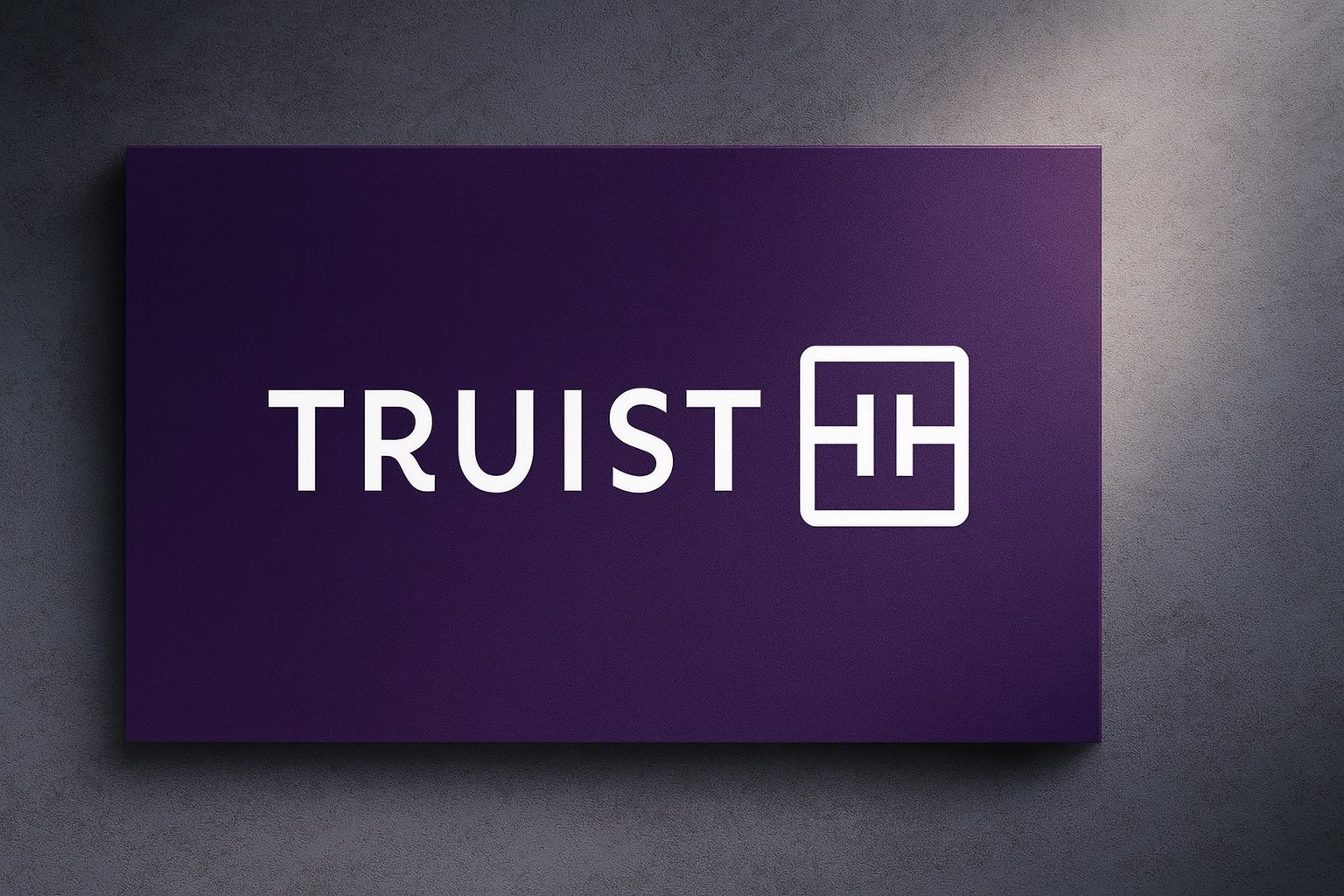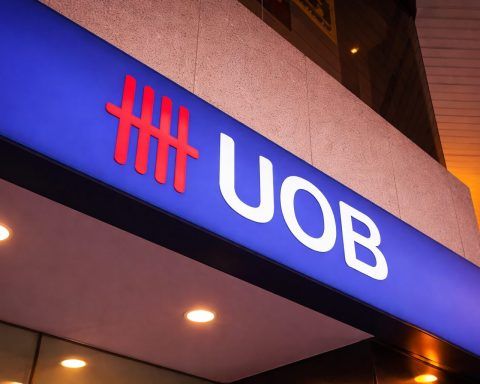- Q3 profit beats forecasts: Truist Financial (NYSE: TFC) posted third-quarter 2025 earnings of $1.04 per share, topping consensus estimates of ~$0.99 [1]. Net income rose to $1.35 billion (vs. $1.34 billion a year ago) on revenue of $5.24 billion [2].
- Stock jumps, lags YTD: Shares spiked ~4% after the earnings announcement [3]. Even so, Truist’s stock is down ~5.3% year-to-date, underperforming the KBW Bank Index’s +12.8% gain [4] amid earlier regional-bank turmoil.
- Hefty 5% dividend yield: At current prices (mid-$40s), Truist yields above 5% annually on its $2.08 per share dividend [5]. The bank maintained its $0.52 quarterly dividend (about a 50% earnings payout) and bought back $500 million in stock in Q3 [6], underscoring shareholder returns.
- Fee income surges, margins steady:Non-interest (fee) income jumped ~11% sequentially, led by a +57.6% spike in investment banking and trading fees and +7.5% wealth-management growth [7]. This robust fee performance offset relatively flat net interest income (up ~1% QoQ to $3.68 billion [8]). Net interest margin held steady at 3.01%, reflecting a resilient lending franchise even as industry NIMs face pressure [9].
- Analysts upbeat – no “sell” calls: Wall Street is strikingly optimistic on Truist. 10 analysts rate TFC a “Buy/Strong Buy” and 13 rate “Hold,” with 0 “Sell” ratings – a rarity in banking [10]. The median 12-month price target is ~$49 (about 15–16% above the latest stock price) [11], signaling expectations of further upside.
- Strong guidance and targets: Executives reaffirmed 2025 guidance of ~1.5–2.5% revenue growth with ~1% expense growth [12], stressing disciplined cost control. Looking longer term, Truist is targeting a 15% return on tangible common equity by 2027 (up from ~13.6% in Q3) [13], indicating confidence in boosting profitability.
- Strategic moves this week: Ahead of earnings, Truist hired two veteran bankers (ex-BofA and PNC) to lead commercial and corporate sales in its Enterprise Payments division [14]. The hires aim to accelerate growth in the booming payments arena, where Truist has seen 14% YoY treasury-fee growth and a 20% expansion in sales teams [15]. The bank also announced a $750 million debt redemption, retiring senior notes due 2026 to reduce interest costs and streamline its balance sheet [16].
Earnings Beat Sparks Relief Rally
Truist’s third-quarter results breezed past expectations, providing a jolt of good news for the regional banking sector. Net income available to common shareholders came in at $1.35 billion (EPS $1.04), exceeding analysts’ $0.99 forecast [17] and slightly above $0.99 in the prior-year quarter. Revenue of $5.24 billion (taxable-equivalent) was roughly in line with estimates [18], as strong fee-based income made up for softer interest income. “Truist delivered strong third-quarter results, underscored by robust fee income growth in investment banking and trading and wealth, healthy loan expansion, and continued expense and credit discipline,” said CEO Bill Rogers in the earnings release [19].
Investors reacted positively. Truist’s stock jumped about 4% in pre-market trading on Oct. 17 after the results [20], and the rally largely held through the trading session. This bounce helped offset recent weakness in bank stocks – just a day earlier, regional banks plunged on renewed credit jitters (the KBW regional bank index fell ~6.5% on Oct. 16 amid loan-loss and fraud fears) [21]. By beating forecasts and showing stable trends, Truist’s report appeared to reassure the market, bucking the pessimism that had briefly clouded the sector.
Notably, Truist’s core fundamentals showed resilience. Net interest income was $3.63–3.68 billion for Q3 (roughly flat year-on-year) [22] [23], as net interest margin (NIM) held at 3.01% [24] despite a challenging rate environment. This suggests Truist managed its deposit costs and loan pricing well even as industry NIMs have been peaking. In fact, the Federal Reserve’s first rate cut of the year in September – after a long tightening cycle – helped ease funding pressures and spur loan demand for banks [25]. With further Fed rate reductions anticipated, optimism is growing that margins and credit growth could improve into 2026 [26]. Truist’s average loans grew a healthy 2.5% quarter-over-quarter (up $7.9 billion) amid “broad-based” growth across consumer and commercial portfolios [27], indicating solid underlying demand as borrowing costs begin to ease.
Crucially, fee income provided a turbo-boost this quarter. Truist’s non-interest income surged ~11% from Q2, reaching $1.56 billion [28]. Investment banking and trading fees leapt 57.6% sequentially [29] – a sharp rebound after prior quarters’ softness – and wealth management income rose 7.5%. This more than offset virtually flat net interest income (up just 1.2% QoQ) [30]. The bank’s diversification paid off: areas like wealth and advisory picked up slack while rate-driven income plateaued. Truist’s own commentary highlighted “robust fee income growth in investment banking… and wealth, [plus] healthy loan expansion” as key drivers of the earnings beat [31]. By contrast, a year ago, capital markets activity was weaker – Truist’s investment banking and trading segment income was down 2.7% year-over-year [32]. Now, a revival in deal-making and trading, alongside record assets under management in its wealth unit (up 6.9% YoY to $374 million in revenue) [33], has swung the pendulum positively.
Stock Performance and Dividend Appeal
Even after this week’s rally, Truist’s stock remains a relative laggard in 2025. Year-to-date, TFC shares have slipped about 5%, significantly underperforming both the broader market and peers – the KBW Bank Index is up nearly 13% in the same period [34]. Much of Truist’s slump occurred earlier in the year amid investor worries over regional bank stability (following the spring 2023 bank failures) and higher interest rates squeezing deposit margins. By mid-October, as fears of a wider credit crunch resurfaced (sparked by a $50 million fraud loss at Zions Bancorp and other one-off shocks), regional bank stocks broadly sold off [35] [36]. Truist was not immune to that sentiment – its shares hit 52-week lows around the low-$40s – but the strong Q3 results have helped turn the narrative more positive.
One standout aspect attracting investors is Truist’s rich dividend yield, now among the highest of large U.S. banks. With an annual dividend of $2.08 per share, and the stock trading around the $42–$44 range, the yield is roughly 5.0% [37]. This is double the S&P 500’s average yield and well above many banking peers. The dividend appears well-supported: Q3’s $0.52 payout represented about half of earnings (50% payout ratio), leaving room for retention, and management affirmed the dividend by declaring the same $0.52 for next quarter [38]. In addition, Truist returned capital via buybacks – repurchasing $500 million in common stock in Q3, which along with the dividend brought total capital return to 87% of earnings [39]. This indicates a shareholder-friendly stance even as the bank prioritizes maintaining strong capital levels.
Importantly, Truist’s capital and credit metrics remain solid. The bank’s CET1 capital ratio stands at 11.0% [40], comfortably above regulatory minimums, reflecting a sizable loss-absorbing buffer. Asset quality is holding up: the net charge-off ratio improved to 0.48% (from 0.51% last quarter) [41], and there’s no sign of deterioration in loan performance so far. These factors give investors confidence that the hefty dividend is sustainable – a crucial point as some smaller regional banks were forced to cut dividends earlier in the year. For income-focused investors, Truist now presents an attractive package of yield and stability. “Truist (TFC) traded with a yield above 5% … while the stock hovered near $41.46” earlier this week, a TS² TechStock market brief noted [42], emphasizing that such a payout can meaningfully boost total returns if it’s maintained. Of course, management’s willingness to deploy excess capital for buybacks (when appropriate) adds another lever for supporting the stock price.
Analyst and Expert Reactions
Wall Street analysts reacted favorably to Truist’s latest results, pointing out the bank’s steady execution in a tricky climate. Remarkably, not a single sell-side analyst holds a “Sell” rating on Truist at the moment [43]. According to Finimize and MarketBeat data, 10 analysts currently rate the stock a “Strong Buy” or “Buy,” 13 rate it “Hold,” and 0 rate “Sell” [44]. “There are no ‘sell’ calls — something you don’t see often in banking these days,” noted a Finimize report on the earnings, highlighting the rarity of such unanimity [45]. The consensus outlook is cautiously optimistic: the average 12-month price target sits around $48–$49, implying roughly 15% upside from current levels [46]. Several analysts have reportedly raised their targets or forecasts following the Q3 beat, encouraged by Truist’s improving trends.
The bullish sentiment is underpinned by Truist’s balanced business model and conservative stance. “Truist’s ability to outpace profit forecasts and keep its numbers steady is winning over Wall Street,” Finimize observed, noting that the stock trades at only ~10× earnings – a modest valuation for a bank of its scale [47] [48]. At roughly a 10 P/E and ~0.9× tangible book value, the market may be pricing in a lot of bad news that didn’t materialize, which leaves room for upside if performance continues to stabilize. No major broker has downgraded the stock in recent weeks; in fact, many have pointed to Truist as a potential rebound candidate among regional lenders. “With a stable price-to-earnings multiple and solid capital reserves, Truist looks well placed to ride out any bumps,” the Finimize briefing added [49], citing the bank’s hefty provisioning and risk controls.
Banking sector experts also highlight Truist’s proactive steps in technology and expense management. Despite industry-wide cost pressures (inflation, wage growth), Truist’s noninterest expenses rose less than 1% year-on-year [50], thanks to efficiency initiatives. Its adjusted efficiency ratio improved to 55.7% this quarter (from 57.1% in Q2) [51] – meaning just 55 cents of every revenue dollar go to expenses – putting it on the better end of peer banks. “Truist’s focus on tech upgrades and stronger risk controls seems to be helping it adapt,” analysts at Finimize noted, explaining that recent investments in digital infrastructure and risk management are already keeping costs in check [52]. Those efforts, while nudging expenses up in the short run, “could actually pave the way for stronger growth down the line,” the analysts added [53]. In other words, management’s long-term bets on innovation (from AI to fintech partnerships) and on prudent underwriting may yield payoffs in the form of market share gains and lower future credit costs.
Broader context also colors analysts’ view. Truist is one of the largest “super-regional” banks in the U.S. (formed via the 2019 BB&T–SunTrust merger), giving it a diverse mix of businesses spanning consumer banking, commercial lending, wealth management, and investment services. That diversification, often cited by bullish analysts, helped the bank weather macro volatility this year. Peer comparisons are telling: many regional banks struggled with declining net interest margins and outflows of uninsured deposits in early 2025, whereas Truist’s large deposit base and higher wealth/fee contributions provided relative stability. By Q3, several mid-sized rivals – e.g. Regions Financial, Fifth Third Bancorp, and Huntington Bancshares – also reported better-than-feared results, suggesting the regional banking group as a whole is more resilient than earlier pessimism implied. “Beyond Truist, its peer regional banks are also earning praise for their resilience in the face of economic uncertainty,” noted Finimize, underscoring a shift in sentiment for the sector [54]. Still, analysts caution that Truist’s stock has room to “catch up”: even after this week’s bounce, TFC trades lower than many comparable banks on a price-to-book basis, and continues to lag big-bank stocks like JPMorgan and Bank of America (which have rallied on stronger trading revenues and deposit inflows). If Truist delivers on earnings and efficiency improvements, some analysts see the valuation gap narrowing.
Strategic Developments and Outlook
Truist’s management used the earnings week to showcase strategic moves aimed at future growth. On Oct. 14, the company announced two high-profile hires to bolster its Enterprise Payments business – a key growth area as digital payments and treasury services demand rises [55]. Elaine Kim, a 20-year industry veteran from Bank of America and J.P. Morgan, was named Head of Commercial Banking Sales, and Rico Iacchetti, with two decades at PNC, joined as Head of Corporate Banking Sales [56] [57]. “These appointments mark the next chapter in our payments evolution,” said Chris Ward, Truist’s head of Enterprise Payments, in the announcement [58]. The goal is to expand Truist’s payments capabilities and client reach in one of the fastest-growing segments of financial services. Both Kim and Iacchetti have track records of driving double-digit revenue growth in payments and fintech-related banking, which Truist hopes will translate into deeper corporate client relationships and fee income. The bank noted that its recent investments in the Enterprise Payments unit have already yielded +14% year-over-year growth in treasury management fees [59]. It has also grown its payments sales team by over 20% in the past year to capture new business [60]. This momentum, coupled with innovations like the Truist Merchant Engage platform for small businesses and Truist’s early adoption of real-time payments networks [61], is positioning the company as a “fast follower” of fintech trends even as it remains a traditional lender at heart.
In another strategic move, Truist is shoring up its balance sheet by redeeming expensive debt. The bank announced on Oct. 16 that it will redeem $750 million of senior notes due October 2026 ahead of schedule [62]. These fixed-to-floating rate notes will be repaid in full on Oct. 28, 2025 (at 100% of principal plus accrued interest) [63]. After that date, interest on the notes will cease, meaning Truist eliminates a chunk of its interest expense going forward. This proactive debt paydown likely reflects confidence in the bank’s capital and liquidity position – essentially, Truist can deploy cash to retire debt and save on interest costs without hurting its ability to lend. It also spares the bank from the higher floating-rate coupons that might have kicked in as the notes neared maturity. Credit analysts saw the move as a prudent de-risking step, especially in a time of volatile interest rates. (Notably, Fitch Ratings affirmed Truist’s ‘A’ credit rating with a Stable outlook earlier in October, citing its solid capitalization and diversified business mix [64].)
Looking ahead, Truist’s management struck a confident but measured tone. The bank is focusing on “execution of our growth strategy, supported by strong capital and investments in talent and technology,” according to its earnings commentary [65]. In practical terms, Truist aims to steadily increase revenues while keeping expenses on a tight leash – the bank reiterated its full-year 2025 outlook for adjusted revenue growth of roughly 1.5–2.5% and expense growth around 1% [66] [67], consistent with prior guidance. Achieving that would be no small feat given the headwinds banks faced earlier in the year (e.g. higher funding costs, slower loan demand). But Q3’s results suggest Truist is on track, having grown revenue ~2% year-to-date and held expense growth under control. The firm’s medium-term targets are equally ambitious: by 2027 it aims for a 15%+ return on tangible common equity (ROTCE) [68], up from about 13–14% currently. That implies expanding profit margins through a combination of higher fee income, improved efficiency, and potentially a more favorable interest-rate environment.
Of course, macroeconomic uncertainties linger. Some analysts note that if interest rates continue to fall, banks’ asset yields will decline and could compress margins – though lower rates also tend to stimulate borrowing and reduce deposit costs, a trade-off that so far has worked in Truist’s favor. Credit quality will be another area to watch into 2026: while Truist’s loan book is performing well now (with delinquencies low and charge-offs modest), any weakening in the economy or specific trouble spots (e.g. commercial real estate or consumer debt stress) could force banks to build reserves. Truist’s diverse portfolio (and exposure to faster-growing Southeast markets) has insulated it from the worst issues plaguing some regional banks, and its management insists it has tightened risk standards in recent years. Still, the company is not complacent – it’s investing in data analytics and risk monitoring to catch problems early, and its current reserve coverage provides a cushion if losses tick up.
Overall, Truist enters the final stretch of 2025 with momentum on its side. The third-quarter performance and subsequent stock bump signal a potential turning point for market sentiment on this bank. “Balanced approach and consistent performance are bringing in positive buzz from analysts and investors alike,” observed Finimize [69]. With a sturdy dividend, improving efficiency, and growth initiatives in key areas like payments and wealth management, Truist Financial appears to be regaining investors’ trust after a rocky period. The stock’s cheap valuation and lack of any bearish analyst calls underscore that the broader financial community sees Truist as a survivor poised to thrive. If the bank can hit its targets and the economy avoids severe shocks, TFC’s comeback story may have further to run, potentially rewarding both income seekers and long-term growth investors who are tuning into this Sunbelt banking powerhouse’s progress.
Sources: Recent TS² TechStock financial briefs and official news releases were referenced for dividend and market data [70] [71]. Earnings figures, analyst sentiments, and executive quotes are sourced from Reuters, Investing.com, Finimize, and Truist’s Q3 press materials [72] [73] [74] [75]. These include Reuters’ report on Truist’s profit uptick [76], Investing.com’s summary of the earnings beat and CEO commentary [77] [78], and Finimize’s analyst insights on the bank’s outlook [79] [80]. The company’s recent press releases on leadership hires and debt redemption [81] [82] provide additional context on strategic initiatives. All in all, the information paints a comprehensive picture of Truist Financial’s current performance and trajectory as of mid-October 2025.
References
1. www.investing.com, 2. www.investing.com, 3. www.investing.com, 4. www.reuters.com, 5. ts2.tech, 6. www.investing.com, 7. www.investing.com, 8. www.investing.com, 9. finimize.com, 10. finimize.com, 11. finimize.com, 12. seekingalpha.com, 13. seekingalpha.com, 14. www.prnewswire.com, 15. www.prnewswire.com, 16. ir.truist.com, 17. www.investing.com, 18. www.investing.com, 19. www.investing.com, 20. www.investing.com, 21. ts2.tech, 22. www.reuters.com, 23. www.investing.com, 24. finimize.com, 25. www.reuters.com, 26. www.reuters.com, 27. www.investing.com, 28. www.investing.com, 29. www.investing.com, 30. www.investing.com, 31. www.investing.com, 32. www.reuters.com, 33. www.reuters.com, 34. www.reuters.com, 35. ts2.tech, 36. ts2.tech, 37. ts2.tech, 38. www.investing.com, 39. www.investing.com, 40. www.investing.com, 41. www.investing.com, 42. ts2.tech, 43. finimize.com, 44. finimize.com, 45. finimize.com, 46. finimize.com, 47. finimize.com, 48. finimize.com, 49. finimize.com, 50. finimize.com, 51. www.investing.com, 52. finimize.com, 53. finimize.com, 54. finimize.com, 55. www.prnewswire.com, 56. www.prnewswire.com, 57. www.prnewswire.com, 58. www.prnewswire.com, 59. www.prnewswire.com, 60. www.prnewswire.com, 61. www.prnewswire.com, 62. ir.truist.com, 63. ir.truist.com, 64. media.truist.com, 65. www.investing.com, 66. www.reuters.com, 67. seekingalpha.com, 68. seekingalpha.com, 69. finimize.com, 70. ts2.tech, 71. ts2.tech, 72. www.reuters.com, 73. www.investing.com, 74. finimize.com, 75. www.prnewswire.com, 76. www.reuters.com, 77. www.investing.com, 78. www.investing.com, 79. finimize.com, 80. finimize.com, 81. www.prnewswire.com, 82. ir.truist.com









